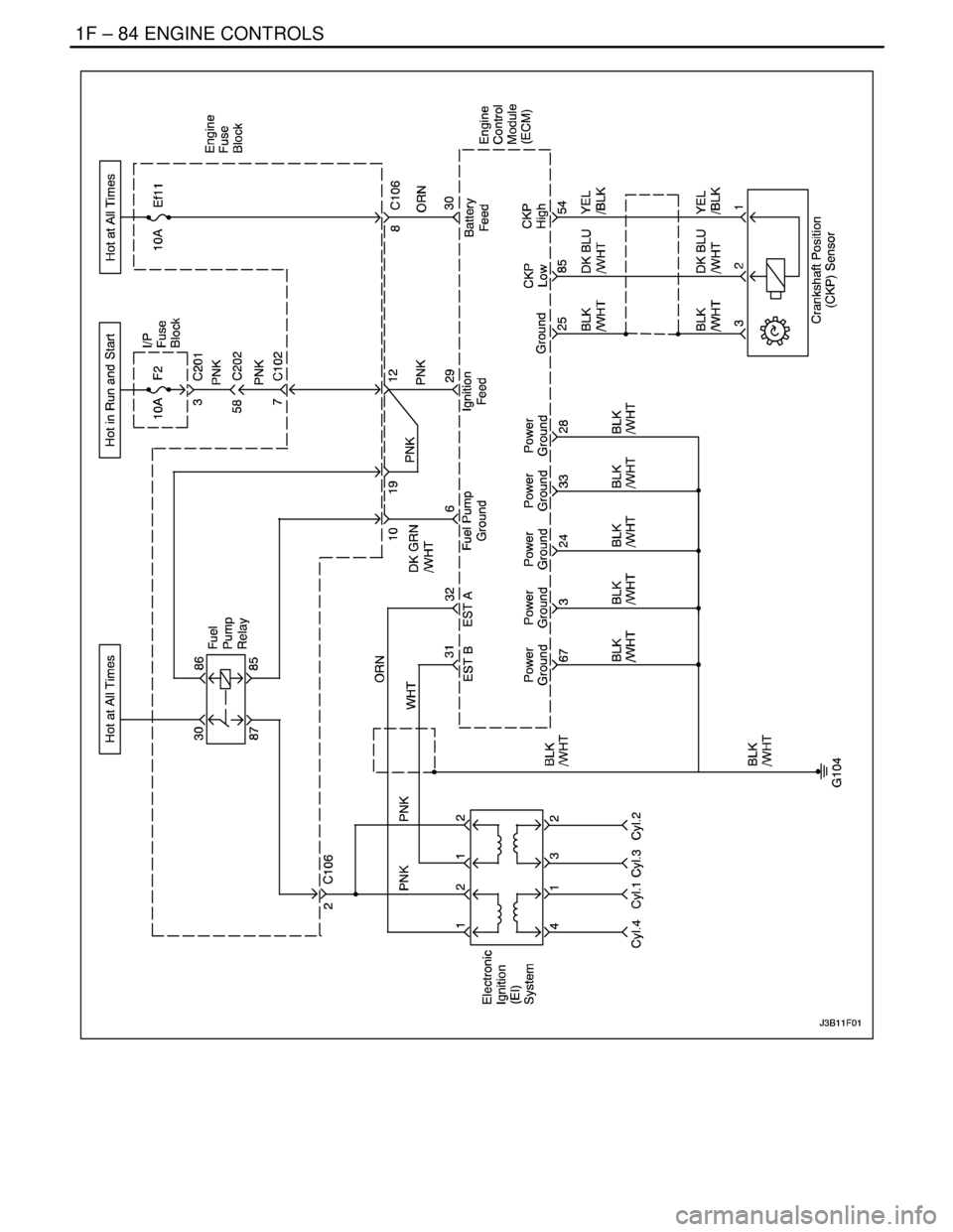2004 DAEWOO LACETTI engine controls
[x] Cancel search: engine controlsPage 325 of 2643

ENGINE CONTROLS 1F – 79
DAEWOO V–121 BL4
IDLE AIR CONTROL SYSTEM CHECK (1.4L/1.6L DOHC)
Circuit Description
The aim of the MTIA (Main Throttle Idle Actuator) is to con-
trol the idle speed with the throttle body itself. The throttle
is motorized for low opening angle (0°C, 19°C). The char-
acteristics of the airflow are not the same for low and high
opening angles. As a matter of fact, the gradient of the
mass air flow function of TPS is lower for small angles that
permits to be more precise during the idle speed control.
Out of idle speed the throttle is actuated mechanically by
a classical bowdencable.
The main throttle idle actuator (MTIA) provides a voltagesignal that changes in relation to the throttle plate angle.
The signal voltage will vary from about nearly 5.0 V at idles
to about 0.2V to 0.4 V at wide–open throttle. The TPS is
one of the most important inputs used by the ECM for fuel
control and other functions such as idle, wide open
throttle, deceleration enleanment, and acceleration en-
richment.
Diagnostic Aids
If the idle is too high, stop the engine. Fully extend the main
throttle idle actuator (MTIA) with a IAC driver. Start the en-
gine. If the idle speed is above 800 rpm, locate and repair
the vacuum leak. Also, check for a binding throttle plate or
throttle linkage or an incorrect base idle setting.
Page 326 of 2643

1F – 80IENGINE CONTROLS
DAEWOO V–121 BL4
Idle Air Control System Check (1.4L/1.6L DOHC)
StepActionValue(s)YesNo
1Perform an On–Board Diagnostic (EOBD) System
Check.
Is the system check complete?–Go to Step 2Go to
”On–Board
Diagnostic Sys-
tem Check”
2Turn the ignition switch to ON.
Is the Malfunction Indicator Lamp (MIL) on steady?–Go to Step 4Go to Step 3
3Turn the ignition switch to LOCK.
Connect the scan tool to the DLC.
Turn the Turn the ignition switch to ON.
Are any diagnostic trouble codes (DTCs) displayed?–Go to Step 4Try with
another scan
tool
4Refer to the applicable DTC table.
Is only one DTC identified as valid trouble code
P0122?–Go to Step 5Go to
applicable DTC
table And go to
”Multiple DTC”
51. Connect the scan tool to the DLC.
2. Turn the ignition switch to ON.
3. Press the accelerator pedal while watching
TPS for smooth changes in the voltage.
Does the scan tool show the TPS voltage change
smoothly within the value specified?0.3V–4.8VGo to
”Diagnostic
Aids”Go to Step 6
61. Turn the ignition switch to lock.
2. Disconnect the MTIA connector.
3. Measure the voltage between terminal 2 and 8.
Does the voltage measure within the value speci-
fied?4.8V–5.0VGo to Step 7Go to Step 8
7Connect a fused jumper between the MTIA connec-
tor terminal 2 and terminal 7.
Does the scan tool show the TPS voltage above val-
ue specified?4.8V–5.0VGo to Step 13Go to Step 11
8Measure the voltage between the MTIA connector
2 and ground.
Does the voltage measure within the value speci-
fied?>5.0VGo to Step 9Go to Step 10
91. Turn the ignition switch to lock.
2. Check for an open or low voltage in the wire
between the MTIA connector 8 and ECM con-
nector 19.
Is the problem found?–Go to Step 12Go to Step 14
101. Turn the ignition switch to LOCK.
2. Check for an open or low voltage in the wire
between the MTIA connector 2 and ECM con-
nector 79.
Is the problem found?–Go to Step 12Go to Step 14
111. Turn the ignition switch to LOCK.
2. Check for an open or low voltage in the wire
between the MTIA connector 7 and ECM con-
nector 74.
Is the problem found?–Go to Step 12Go to Step 14
Page 327 of 2643

ENGINE CONTROLS 1F – 81
DAEWOO V–121 BL4
StepNo Yes Value(s) Action
121. Repair the wire or the connector terminal as
needed.
2. Clear any DTCs from ECM.
3. Perform the Diagnostic System Check.
Is the repair complete?–System OK–
131. Replace the throttle body assembly.
2. Clear any DTCs from ECM.
3. Perform the Diagnostic System Check.
Is the repair complete?–System OK–
141. Turn the ignition switch to LOCK.
2. Replace the ECM.
3. Perform the Diagnostic System Check.
Is the repair complete?–Go to Step 15–
15Check if any additional DTCs are set.
Are any DTCs displaced that have not been diag-
nosed?–Go to
applicable DTC
tableSystem OK
Page 328 of 2643

1F – 82IENGINE CONTROLS
DAEWOO V–121 BL4
IDLE AIR CONTROL SYSTEM CHECK (1.8L DOHC)
Circuit Description
The Engine Control Module (ECM) controls the engine idle
speed with the Idle Air Control (IAC) valve. To increase the
idle speed, the ECM pulls the IAC pintle away from its seat,
allowing more air to pass by the throttle body. To decrease
the idle speed, it extends the IAC valve pintle toward its
seat, reducing bypass air flow. A scan tool will read the
ECM commands to the IAC valve in counts. The higher
counts indicate more air bypass (higher idle). The lower
counts indicate less air is allowed to bypass (lower idle).
Diagnostic Aids
If the idle is too high, stop the engine. Fully extend the Idle
Air Control (IAC) valve with a IAC driver. Start the engine.
If the idle speed is above 800 rpm, locate and repair the
vacuum leak. Also, check for a binding throttle plate or
throttle linkage or an incorrect base idle setting.
Test Description
The number(s) below refer to step(s) on the diagnostic
table.
2. The IAC valve is extended and retracted by the IAC
driver. IAC valve movement is verified by an engine
speed change. If no change in engine speed oc-
curs, the valve can be removed from the throttle
body and tested. Connect the IAC driver to the re-
moved IAC valve and turn the ignition ON. Do not
start the engine.5. This step checks the quality of the IAC valve move-
ment in Step 2. Fully extending the IAC valve may
cause an engine stall. This may be normal.
6. Steps 2 and 5 verify proper IAC valve operation.
This step checks the IAC circuit for a wiring or ECM
fault.
Idle Air Control Valve Reset Procedure
Whenever the battery cable or the Engine Control Module
(ECM) connector or the ECM fuse Ef11 is disconnected or
replaced, the following idle learn procedure must be per-
formed:
1. Turn the ignition ON for 5 seconds.
2. Turn the ignition OFF for 10 seconds.
3. Turn the ignition ON for 5 seconds.
4. Start the engine in park/neutral.
5. Allow the engine to run until the engine coolant is
above 185°F (85°C).
6. Turn the A/C ON for 10 seconds, if equipped.
7. Turn the A/C OFF for 10 seconds, if equipped.
8. If the vehicle is equipped with an automatic trans-
axle, apply the parking brake. While pressing the
brake pedal, place the transaxle in D (drive).
9. Turn the A/C ON for 10 seconds, if equipped.
10. Turn the A/C OFF for 10 seconds, if equipped.
11. Turn the ignition OFF. The idle learn procedure is
complete.
Page 329 of 2643

ENGINE CONTROLS 1F – 83
DAEWOO V–121 BL4
Idle Air Control System Check (1.8L DOHC)
StepActionValue(s)YesNo
1Perform an On–Board Diagnostic (EOBD) system
check.
Was the check performed?–Go to Step 2Go to
”On–Board
Diagnostic Sys-
tem Check”
21. Turn the ignition OFF.
2. Remove Idle Air Control (IAC) valve.
3. Inspect the IAC passages for restrictions.
Is the problem found?–Go to Step 3Go to Step 4
3Clean the IAC passages.
Is the repair complete?–System OK–
4Measure the resistance between following terminals
of IAC valve.
1. Terminal C and D
2. Terminal A and B
Does the resistance equal to the value specified?40–80Go to Step 6Go to Step 5
5Replace the IAC valve.
Is the repair complete?–System OK–
61. Disconnect the Engine control Module (ECM)
connector.
2. Check for an open or short in the wires be-
tween following terminals.
S Terminal D of IAC valve connector and ter-
minal M13 of ECM connector
S Terminal C of IAC valve connector and ter-
minal M15 of ECM connector
S Terminal B of IAC valve connector and ter-
minal M30 of ECM connector
S Terminal A of IAC valve connector and ter-
minal M14 of ECM connector
Is the problem found?–Go to Step 8Go to Step 7
7Repair an open or short circuit as needed.
Is the repair complete?–System OK–
8Inspect the IAC connector terminals and the ECM
connector terminals.
Is the problem found?–Go to Step 9Go to Step 10
9Repair or replace the throttle body assembly and/or
ECM connector terminals as needed.
Is the repair complete?–System OK–
10Replace the ECM.
Is the repair complete?–System OK–
Page 330 of 2643

1F – 84IENGINE CONTROLS
DAEWOO V–121 BL4
Page 331 of 2643

ENGINE CONTROLS 1F – 85
DAEWOO V–121 BL4
IGNITION SYSTEM CHECK (1.4L/1.6L DOHC)
Circuit Description
The Electronic Ignition (EI) system uses a waste spark
method of spark distribution. In this type of EI system, the
Crankshaft Position (CKP) sensor is mounted to the oil
pump near a slotted wheel that is a part of the crankshaft
pulley. The CKP sensor sends reference pulses to the en-
gine control module (ECM). The ECM then triggers the EI
system ignition coil. Once the ECM triggers the EI system
ignition coil, both of the connected spark plugs fire at the
same time. One cylinder is on its compression stroke at
the same time that the other is on the exhaust stroke, re-
sulting in lower energy needed to fire the spark plug in the
cylinder on its exhaust stroke.
This leaves the remainder of the high voltage to be used
to fire the spark plug in the cylinder on its compression
stroke. Since the CKP sensor is in a fixed position, timing
adjustments are not possible or needed.
Test Description
The number(s) below refer to step(s) on the diagnostictable.
2. It is important to check for the presence of spark to
all of the cylinders to isolate the problem to either
EI system ignition coil inputs or outputs.
5. In checking the ECM outputs for the electronic
spark timing signal, it recommended to use an os-
cilloscope to view the varying voltage signals. In
measuring these outputs with a voltmeter, intermit-
tent errors may occur that cannot be seen by a volt-
meter.
6. After confirming ECM inputs for the electronic spark
timing to the EI system ignition coil are OK, it can
be determined that a faulty EI system ignition coil is
at fault.
11. After confirming proper CKP sensor inputs to the
ECM and no wiring problems present, it can be de-
termined that the ECM is at fault.
24. This step, along with step 25, checks for battery
voltage and a ground to the EI system ignition coil.
Ignition System Check (1.4L/1.6L DOHC)
CAUTION : Use only electrically insulated pliers when handling ignition wires with the engine running to prevent
an electrical shock.
Step
ActionValue(s)YesNo
11. Remove the spark plugs.
2. Inspect for wet spark plugs, cracks, wear, im-
proper gap, burned electrodes, or heavy de-
posits.
3. Replace the spark plugs as needed.
Is the repair complete?–System OKGo to Step 2
2Check for the presence of spark from all of the igni-
tion wires while cranking the engine.
Is spark present from all of the ignition wires?–System OKGo to Step 3
31. Measure the resistance of the ignition wires.
2. Replace any ignition wire(s) with a resistance
above the value specified.
3. Check for the presence of spark from all of the
ignition wires.
Is spark present from all of the ignition wires?30,000 WSystem OKGo to Step 4
4Is spark present from at least one of the ignition
wires, but not all of the ignition wires?–Go to Step 5Go to Step 12
51. Turn the ignition OFF.
2. Disconnect the Electronic Ignition (EI) system
ignition coil connector.
3. While cranking the engine, measure the volt-
age at the EI system ignition coil connector
terminal 1.
Does the voltage fluctuate within the values speci-
fied?0.2–2.0 vGo to Step 6Go to Step 7
Page 332 of 2643

1F – 86IENGINE CONTROLS
DAEWOO V–121 BL4
StepNo Yes Value(s) Action
6While cranking the engine, measure the voltage at
the EI system ignition coil connector terminal 1.
Does the voltage fluctuate within the values speci-
fied?0.2–2.0 vGo to Step 10Go to Step 8
7Check for an open in the wire from the EI system
ignition coil connector terminal 1 to the engine con-
trol module (ECM) connector terminal 31.
Is the problem found?–Go to Step 9Go to Step 11
8Check for an open in the wire from the EI system
ignition coil connector terminal 1 to the ECM connec-
tor terminal 32.
Is the problem found?–Go to Step 9Go to Step 11
91. Repair the wiring as needed.
2. Connect the EI system ignition coil connector.
3. Check for the presence of spark from all of the
ignition wires.
Is spark present from all of the ignition wires?–System OK–
101. Turn the ignition OFF.
2. Replace the electronic ignition system ignition
coil.
3. Connect the EI system ignition coil connector.
4. Check for the presence of spark from all of the
ignition wires.
Is spark present from all of the ignition wires?–System OK–
111. Turn the ignition OFF.
2. Replace the ECM.
3. Connect the EI system ignition coil connector.
4. Check for the presence of spark from all of the
ignition wires.
Is spark present from all of the ignition wires?–System OK–
121. Turn the ignition OFF.
2. Disconnect the Crankshaft Position (CKP) sen-
sor connector.
3. Measure the resistance between the CKP sen-
sor terminals 1 and 2.
Is the resistance within the value specified?400–600 WGo to Step 13Go to Step 28
131. Measure the resistance between the CKP sen-
sor terminals 1 and 3.
2. Measure the resistance between the CKP sen-
sor terminals 2 and 3.
3. Is the resistance infinite (open circuit)?
Is the repair complete?–Go to Step 14Go to Step 28
141. Turn the ignition ON.
2. Measure the voltage between the CKP sensor
connector terminals 1 and 3.
Is the voltage within the value specified?1.3–1.5 v
(2.4–2.7 v)*Go to Step 20Go to Step 15
15Measure the voltage between the CKP sensor con-
nector terminal 1 and ground.
Is the voltage within the value specified?1.3–1.5 v
(2.4–2.7 v)*Go to Step 17Go to Step 16